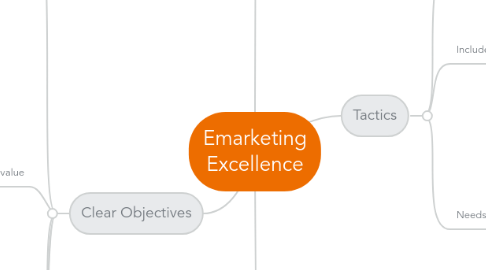
1. Clear Objectives
1.1. Sell: Grow sales
1.1.1. Set the Sell objectives
1.1.1.1. The direct online revenue contribution for each product/market
1.1.1.2. Indirect online revenue contribution: portion of sales that are influenced by digital communications
1.1.1.3. Reach
1.1.2. Value events
1.1.2.1. Sale
1.1.2.2. Lead
1.1.2.3. Newsletter
1.1.2.4. Searches
1.1.2.5. Product page views
1.1.2.6. Product documents downloads
1.1.3. Sell what to whom
1.1.3.1. New Markets + Existing products: Market development strategies
1.1.3.2. New Markets + New products: Diversification strategies
1.1.3.3. Existing markets + Existing products: penetration strategies
1.1.3.4. Existing markets + New products: product development strategies
1.2. Serving: Add value
1.2.1. a Web presence can be used to add value for costumers at different stages: pre-sales, during sale or sales support
1.3. Speak: Get closer to costumers
1.3.1. Speak
1.3.1.1. Communicate special offers
1.3.1.2. Shape costumer opinion
1.3.1.3. Build brand
1.3.1.4. Increase awareness
1.3.2. Listen
1.3.2.1. Chat rooms
1.3.2.2. Questionnaires
1.3.2.3. Open questions
1.3.3. Key digital media channels
1.3.3.1. Search engine marketing
1.3.3.2. Online PR
1.3.3.3. Online partnerships
1.3.3.4. Interactive advertising
1.3.3.5. Opt-in email
1.3.3.6. Viral marketing
1.4. Save Costs
1.4.1. Save money, time and efforts or generate extra revenues
1.4.2. CPA (allowable cost per acquisition) = cost Per click /conversion rate
1.5. Sizzle: Extend the brand online
1.5.1. What experience could a web site deliver that would be truly unique of a brand?
1.5.2. Add value online
2. Costumer Engagement
2.1. Measures
2.1.1. % of non-home page entry visits
2.1.2. Bounce rate
2.1.3. Duration on site
2.1.4. Marketing outcomes
2.1.5. Micro or step conversion rates
2.1.6. Brand search term strenght
2.1.7. E mail activity level
2.1.8. Emotional response
2.1.9. Outcomes
3. E-Strategy
3.1. Influence by
3.1.1. Amount of resources avaible
3.1.2. Priorization of objectives
3.2. Should identify
3.2.1. Target markets
3.2.2. Positioning
3.2.3. Online Value proposition
3.2.4. Choice of mix digital media channel
3.2.5. Contact strategies
3.3. Key elements
3.3.1. Delivers against goals
3.3.2. OVP
3.3.3. Prioritize audiences
3.3.4. Prioritize products
3.3.5. Define the mix of digital channels
3.4. Choices of marketing services Chaffey et al (2003)
3.4.1. 0. No presence on web
3.4.2. 1. Basic web presence (no web site)
3.4.3. 2. Basic product information "brochureware"
3.4.4. 3. User are able to search the site and make queries.
3.4.5. 4. Interactive site
3.4.6. 5. Fully interactive site supporting the whole buying process
4. Tactics
4.1. Details of the strategy
4.2. Includes
4.2.1. web site
4.2.2. Opt-in e-mail
4.2.3. Digital media channels
4.2.4. Virtual Exhibitions
4.2.5. Sponsorship
4.3. Needs control
4.3.1. i.e
4.3.1.1. Measuring number of hits
4.3.1.2. number of unique visitors
4.3.1.3. number of conversions
4.3.1.4. Churn rate
4.3.1.5. Competitive intelligence
